‘Jaws’: 50 years of teeth, fins and watching where you swim
Several books and a documentary mark the 50th anniversary of Spielberg’s iconic film, as scientists work to dispel the fear it sparked and put the actual danger of sharks into perspective
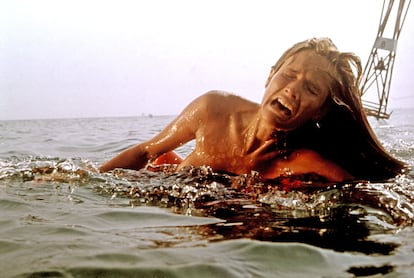
What has white teeth, makes millions of dollars, devours women, and isn’t Warren Beatty? Let’s start with this politically incorrect riddle-joke — it was the 1970s, after all — by critic and TV presenter Barry Norman (the answer was obviously Jaws) to talk about Steven Spielberg’s famous film, which this Friday, June 20, marks an incredible 50 years since its release in the United States.
Everything about Jaws — that brilliant blend of jaws, fin, and the fear of not knowing what’s lurking below — demands the use of superlatives: a simultaneous release in 400 U.S. theaters, a box-office smash (the first film to gross over $100 million, now nearing $500 million, on a budget of $8 million); the creation of an entirely new (aquatic) subgenre of natural horror that continues to this day with offshoots of sharkploitation, like the Sharknado saga or The Meg films; the launch of the most famous filmmaker’s career in history, granting him independence and creative freedom; a global collective psychosis and generations of traumatized viewers; and interpretations that see in the story allusions to Watergate, the murder of Sharon Tate, the Vietnam War, the dehumanization and corruption of capitalism, class struggle, and the destruction of the American way of life…
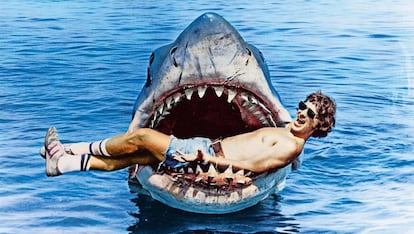
Not to mention the star itself: a huge great white shark — though not exaggerated, measuring 7.6 meters and weighing three tons, at the upper end of the species’ range; the film stayed true to reality in that regard. The on-screen shark would turn these powerful and fascinating animals into the epitome of the darkest and most destructive forces of nature, reigniting in millions a deep-rooted fear of the sea and its creatures. Goodbye lions and tigers: after this film, the great devourer of men — very unfairly, as statistics show — became, in the popular imagination, the great white shark (Carcharodon carcharias).
Along with it, all other shark species — tiger sharks, makos, hammerheads, threshers, bulls, blacktip or whitetip, gray reef sharks, even blue sharks — were no longer just potentially dangerous but seen as lethal and destructive (and therefore, expendable). No fin breaking the surface of the waves, no fusiform shadow beneath the ocean was free from the imagined red stain of (human) blood. The shark began to swim ominously through the collective subconscious, with some rare sexual undertones, as hinted at in the novel’s cover and the movie posters, becoming public enemy number one.
The trailer for the film — which was a pioneer in massive movie promotion (its campaign included beach towels!) — set the tone: (read in a deep, ominous voice) “There is a creature alive today who has survived millions of years of evolution, without change, without passion, and without logic. It lives to kill. A mindless eating machine. It will attack and devour anything. It is as if God created the Devil, and gave him... Jaws.”
The excellent documentary 50 Years of Jaws, by Antoine Coursat and Olivier Bennard — one of several anniversary releases — captures the panic the film unleashed in theaters. Footage from inside cinemas shows the shock and dread triggered by scenes like the sudden appearance of fisherman Ben Gardner’s grimacing, severed head in his half-sunken boat, discovered underwater by oceanographer Hooper (Richard Dreyfuss). Audience comments after screenings included: “I was terrified,” “It was horrible — but so good”; “Do you think a shark like that could exist?” “I don’t know, but I’m never swimming again!” First time seeing it? “No, the ninth.” And what keeps you coming back? “The shark!”
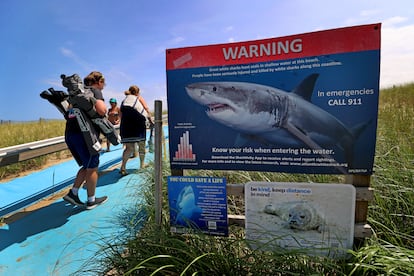
“The first time we saw it, in New York,” explains Wendy Benchley, widow of the late Peter Benchley — the author of the book Jaws, who died in 2006 — in the documentary, “people were amazed, clapping and screaming. As we came out, Richard Dreyffus started jumping around and shouting ‘A hit!’ But there was also this other phenomenon of psychosis combined with anxiety.”
Jaws unleashed massive shock and a wave of shark-mania: the creature even had its own record, Super Jaws, by the Seven Seas, and made the cover of Time magazine. The fear of swimming was so widespread that a Florida community actually tried to sue the film for keeping people away from the beaches. Ian Shaw, son of actor Robert Shaw — who played the grizzled shark hunter Quint — admits in the documentary: “I didn’t even want to swim in a pool.” That’s what happens when you watch a shark eat your father on screen.
Spielberg — then a young, ambitious, and rather mischievous 27-year-old director with only two films under his belt — came close to disaster during the shoot, which ran far over schedule and over budget. Some of the choices he made, like showing the shark very little, were born out of necessity: the three mechanical sharks built for the film — all named Bruce, after the director’s lawyer, and unofficially nicknamed “the great white turd” — didn’t work properly and didn’t look convincing. In fact, during the first attack scene, the shark sank.
The crew had a terrible time filming in the water, and the actors clashed (just like the malfunctioning sharks). The production was plagued with mishaps and marred by the local townspeople’s attempts to cash in at first, followed by growing hostility. The story can be read in some of the chapters of Tiburón El libro del 50 aniversario (Jaws: The 50th Anniversary book) and in The Jaws Log: Expanded Edition by screenwriter Carl Gottlieb.
“Of course I remember the premiere of Jaws, I was 16 years old, I saw it in Barcelona at the Bosque cinema, and ever since then, you’d go swimming with a certain hesitation," marine biologist and aquarium business owner Adolfo Santa-Olalla tells EL PAÍS. “It was a shock — people would go into the water with a nervous ‘uh-oh’ on their lips. We had a small boat in Blanes and we’d go out, but I’ve never swum in open water again. Getting to know marine life has only confirmed that there are bad creatures out there."
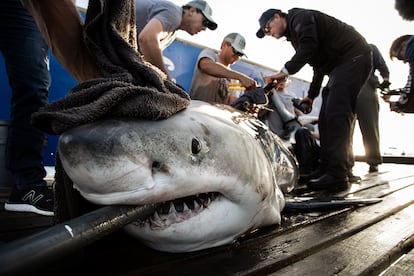
This is confirmed by diver Ernest de Longis, who in 2009 was attacked not by a shark but by a swordfish off the coast of Ibiza. An Italian from Benevento, Ernest was very young when Spielberg’s film premiered, but he already knew the sea and found it “very exaggerated.” He once encountered a great white — one of the largest ever seen in the Mediterranean — caught in 1987 in the tuna traps off Favignana, his grandmother’s island. The shark was hauled to the dock and put on display (he shows impressive photos), drawing as much attention as the tiger shark shown off in Jaws when the townspeople of Amity believe it to be the killer. That shark, by the way, has its own juicy backstory: it was flown in from Florida and stank terribly during the shoot.
Another person who saw Jaws at its Spanish premiere is Patricio Bultó, marine biologist and technical director of the Barcelona Aquarium, which houses a good collection of sharks, along with a life-size replica of a great white. “I wasn’t afraid,” he says. “I was already interested in sharks at the time.” He adds: “I liked the movie, although I thought it was all very exaggerated.”
Catalan marine scientist Gádor Muntaner, an international shark expert, recently published the book La sonrisa de los tiburones (The Smile of Sharks) — a title that’s a clear statement of intent. At 34, Gádor didn’t experience the film’s original impact. In fact, she refers to the great white as “my great love” and says that seeing one makes her cry from emotion (not fear, as it does for many of us).
“I have a conflicted relationship with the film,” she explains during one of the few moments she’s not in the water swimming with sharks — her greatest passion. “On one hand, I can’t deny that it’s a cinematic masterpiece that marked a turning point in film history. But I can’t help holding a grudge against it. Even if unintentionally, it did enormous damage to an essential ocean animal. The film planted a deep global fear of sharks, which indirectly contributed to an even greater rise in captures, since people had no empathy for them.”
Gádor continues: “The image we get of sharks from the movie is far from reality. Humans aren’t part of their natural diet, and they’re not drawn to us as food. The stats prove it: you’re more likely to be struck by lightning than bitten by a shark.”
The scientist, who says the only things she fears in the ocean are propellers and currents — and was once startled by a leopard seal, which by contrast, seems cute — points out that sharks cause about 10 human deaths a year worldwide, while dogs cause 30,000. Meanwhile, humans kill around 100 million sharks annually, many due to the brutal practice of finning — the slicing off of fins for soup. It’s worth remembering that despite all the panic, Spielberg’s shark in Jaws only kills six people and one dog in the entire film.
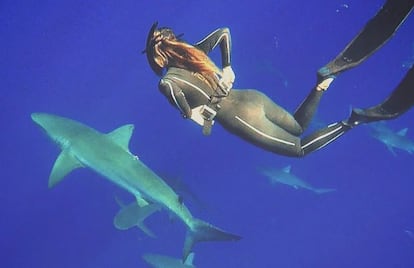
The Smile of Sharks is an excellent read to counterbalance the 50th anniversary book about Jaws. It highlights how we still receive stereotyped, inaccurate, sensationalist, and incomplete information about sharks, and instead portrays them as admirable, perfect, and fascinating creatures. It’s striking to compare what marine biologist Gádor Muntaner writes about the gaze of the great white shark (“those blue-irised eyes that seem to see beyond the visible”) with the famous monologue by Captain Quint (Robert Shaw) describing sharks as having “lifeless eyes, black eyes, like a doll’s eyes” just before an attack.
That said, Gádor is no naive idealist — she acknowledges that sharks can and do attack: “The statistics are minimal, but the risk exists.” In fact, a moving chapter of her book is devoted to a documentary filmed with her and an Australian ex-marine who had lost an arm and a leg in a shark attack and later became a marine conservationist. It was filmed in the fishing village of Yavaros, on the coast of Sonora in Mexico, where four fatal great white shark attacks had occurred. Gádor believes the attacks were likely caused by predator confusion: the water was extremely murky, and the victims were harvesting callo de hacha (pen shell clams, a prized species) from the sandy seabed.
Even Peter Benchley himself became aware of the harm his novel had done to the reputation of sharks and later turned to marine conservation, saying he wanted to give back something for all they had given him. In the foreword to the new editions of his novel — and also in the anniversary edition, which includes extra material such as the amusing struggle to find a title for the book (at one point, they jokingly suggested Something’s Biting My Leg) — his widow, Wendy Benchley, explains: “Sharks are not monsters, they are an essential part of the ocean.” She believes that while Jaws may have demonized sharks, it also sparked worldwide interest in them, inspired many to study them, and spurred scientific research.
The film was shot on Martha’s Vineyard in Massachusetts, which stood in for the fictional town of Amity. But the true origin of Jaws lies on the nearby island of Nantucket, where Benchley grew up. There, he met a real-life shark fisherman — Frank Mundus, a Quint-like character — who had once harpooned a great white. This encounter made Benchley wonder what might happen if such a predator showed up in a beach town during tourist season. The Nantucket connection also explains the strong Moby Dick undertones in the story (with Quint serving as a rough, beer-guzzling Ahab).
The backstory of the novel (Benchley’s debut) is just as compelling as that of the film. He had been developing the idea for years and conducted extensive research, but no one seemed interested in a book centered on a fish — even with the precedent of Hemingway’s The Old Man and the Sea. At the time, however, a novel about rabbits (Watership Down) was topping bestseller lists.
Spielberg, for his part, stripped out much of the book’s darker material — including its sex and corruption — such as Chief Brody’s wife’s unhappy marriage and her affair with Hooper (who dies in the novel, unlike in the film), and the mayor’s mafia ties. The novel also features a memorable opening: “The great fish moved silently through the night water.” And it doesn’t shy away from gore: “She could not find her foot. She reached higher on her leg, and then she was overcome by a rush of nausea and dizziness. Her groping fingers had found a hub of bone and tattered flesh.”
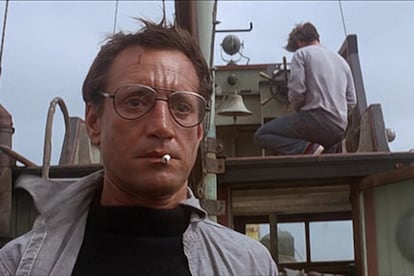
Scientists remind us that sharks have been swimming the oceans for over 400 million years with little evolutionary change (except, thankfully for the megalodon’s size — which was a 17-meter white shark). Today there are about 500 species, including extraordinary ones like the whale shark and the Greenland shark, which can live so long that some individuals might’ve been alive when Cervantes was.
I also saw Jaws at the Bosque cinema in Barcelona. The experience wasn’t quite as traumatic for me as for others — perhaps because I already carried fear within me, thanks to the terrifying shark stories told by my mother, who spent her youth in Venezuela and personally witnessed attacks. She even saw a cousin (a seminarian) have his leg eaten in Maracaibo — oddly, it didn’t make her any less religious.
My own encounters with sharks have been few, including seeing a fin from a beach in Nantucket and, more dramatically, seeing one while snorkeling in Cayo Sombrero, off the Venezuelan coast. I admit I swam away as fast as I could. (Whereas, in the same situation in the Maldives, Gádor swam toward the shark.) Meanwhile, I couldn’t stop hearing the haunting, obsessive notes of John Williams’s soundtrack — the “underwater ostinato,” as Quim Casas calls it — which, fun fact, made Spielberg laugh the first time he heard it because he thought such minimalist music had to be a joke.
Another fascinating recent book is Sharks Don’t Sink, by Jasmin Graham, a shark expert and founder of Minorities in Shark Sciences (MISS). Specializing in hammerheads, Graham describes her fight to change popular perceptions of sharks — “the most extraordinary creatures in existence” — while also advocating for Black women scientists like herself in the historically white, male-dominated world of American marine science.
“Just as we Black women scientists have struggled to thrive in our field,” she writes, “sharks have struggled to survive, too.” She draws a provocative parallel: “All too often Black people are perceived and mistreated much like sharks; feared, misunderstoodand brutalized, often without recourse.” It’s telling, and racist, that some people believe sharks don’t attack Black people — something evidence disproves.
The researcher warns that in the last century, some shark populations have dropped by 90%, and a quarter of all species are endangered. Graham stresses sharks’ vital importance for marine ecosystems and all the lessons they can teach us about life, survival, and resilience. One of her quotes is especially thought-provoking and contrasts starkly with the film’s message: “If sharks stop swimming, we all sink.”
Besides the compulsive habit of glancing downward while swimming in the ocean, Jaws has also left us a handful of iconic scenes and lines. Among the former: the opening scene of the woman swimming naked at night while the predator (unseen) rises from the depths; Quint’s first appearance, his nails scratching the chalkboard; the crowd fleeing the sea (“Everyone get out of the water!”); the shark tracking barrels; the attack on Hooper’s diving cage; or the terrifying moment the shark devours Quint on the sinking Orca.
And don’t forget the moment when Quint crushes the beer can with his hand and Hooper does the same with his paper cup. Or the talks about sharks aboard the Orca, including the chilling story of the USS Indianapolis, when Quint explains the reason for his hatred of sharks. This scene — which was not part of the novel — was written by ghost co-writer Howard Sackler, then reworked by John Milius and Robert Shaw himself.
And then there are the unforgettable quotes: “You’re gonna need a bigger boat” (improvised by Roy Scheider); “Smile, you son of a bitch”; “This is not a boat accident! It wasn’tanypropeller, it wasn’t any coral reef, and it wasn’t Jack the Ripper!”; or “Amity, as you know, means friendship.”
Jaws has been swimming in our minds for 50 years now, and even though times have changed since the film was made, something of ourselves remains caught up in the pursuit of that enormous shark — that great adventure full of risks and emotions that ultimately is life itself.
Sign up for our weekly newsletter to get more English-language news coverage from EL PAÍS USA Edition
Tu suscripción se está usando en otro dispositivo
¿Quieres añadir otro usuario a tu suscripción?
Si continúas leyendo en este dispositivo, no se podrá leer en el otro.
FlechaTu suscripción se está usando en otro dispositivo y solo puedes acceder a EL PAÍS desde un dispositivo a la vez.
Si quieres compartir tu cuenta, cambia tu suscripción a la modalidad Premium, así podrás añadir otro usuario. Cada uno accederá con su propia cuenta de email, lo que os permitirá personalizar vuestra experiencia en EL PAÍS.
¿Tienes una suscripción de empresa? Accede aquí para contratar más cuentas.
En el caso de no saber quién está usando tu cuenta, te recomendamos cambiar tu contraseña aquí.
Si decides continuar compartiendo tu cuenta, este mensaje se mostrará en tu dispositivo y en el de la otra persona que está usando tu cuenta de forma indefinida, afectando a tu experiencia de lectura. Puedes consultar aquí los términos y condiciones de la suscripción digital.
More information
Archived In
Últimas noticias
Rowan Atkinson tops Netflix at 70: ‘He’s as funny as ever’
Israeli recognition of Somaliland stirs up the Gulf
Tiger Woods turns 50: Will he continue playing on the PGA Tour or take a back seat?
The surreal journey of James Nnaji, the Barcelona youth player selected in the NBA Draft who ended up in the NCAA
Most viewed
- Oona Chaplin: ‘I told James Cameron that I was living in a treehouse and starting a permaculture project with a friend’
- Reinhard Genzel, Nobel laureate in physics: ‘One-minute videos will never give you the truth’
- Sinaloa Cartel war is taking its toll on Los Chapitos
- Why the price of coffee has skyrocketed: from Brazilian plantations to specialty coffee houses
- Chevy Chase, the beloved comedian who was a monster off camera: ‘Not everyone hated him, just the people who’ve worked with him’










































